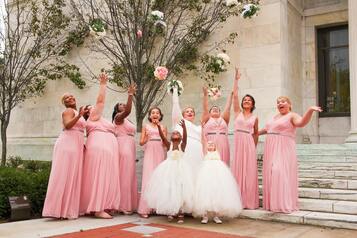
As Covid-19 restrictions have had a massive influence on the trend towards smaller weddings, it's inevitable that smaller weddings would also result in smaller bridal parties. However, even before Covid there was a trend towards having less bridesmaids and/or groomsmen, or perhaps none at all. So, how many people should you have in your bridal party (groomsmen/bridesmaids)? Do you have to have any?
The only 'rules' around bridal parties is the statutory requirement that you must have two witnesses at your wedding, in addition to the Celebrant. That is why, during Covid lockdowns, the maximum number for weddings was set at 5 - the marrying couple, two witnesses, and Celebrant. It has been a tradition that the two witnesses who sign the legal documents are the best-man and chief bridesmaid, but it's only a tradition. Changes to the Marriage Act which allowed same-sex marriages also contributed in significant ways to how we celebrate marriages, including 'support-people' (after all, we can't have a 'bridal party' if there is no bride!). Here are some of the trends I'm seeing:
The only 'rules' around bridal parties is the statutory requirement that you must have two witnesses at your wedding, in addition to the Celebrant. That is why, during Covid lockdowns, the maximum number for weddings was set at 5 - the marrying couple, two witnesses, and Celebrant. It has been a tradition that the two witnesses who sign the legal documents are the best-man and chief bridesmaid, but it's only a tradition. Changes to the Marriage Act which allowed same-sex marriages also contributed in significant ways to how we celebrate marriages, including 'support-people' (after all, we can't have a 'bridal party' if there is no bride!). Here are some of the trends I'm seeing:
- While large bridal parties are still popular, I'm seeing more weddings with only one or two people accompanying each of the marrying parties (whether bride and groom, or bride and bride, or groom and groom), or none at all.
- Gone are the days when on one side of the Celebrant stood an all-male group (the groom and groomsmen) and an all-female group on the other (bride and bridesmaids). This doesn't mean with same-sex weddings we're seeing all men, or all women, either. Most people have both male and female friends, and if a groom would like to have a female friend in his bridal party there is no good reason why she should stand with the bridesmaids on the bride's side, and vice versa.
- I conducted a lovely ceremony where both the bride and groom had children from previous marriages (coincidentally they had the same number of children, roughly the same ages). The children stood on their respective sides and when it came time to ask "Who brings Sonia to be married to Mark?" Sonia's children answered in unison "We do!" and when I asked "Who brings Mark to be married to Sonia?" Mark's children answered "We do!"
- On the subject of bridal parties I am sometimes asked about whether or not brides and grooms should give their support-people gifts, and, if so, what kind of gift is appropriate. Personally, I think being invited to play a role in a friend's wedding is gift enough! I've been best-man for a couple weddings and didn't expect a gift (and I don't think I was given one either), and I don't recall giving gifts to my four groomsmen either. I don't think it's expected, and it's another expense which can turn a happy occasion into a financial burden.
Photo by Maria Lindsey Multimedia Creator from Pexels
 RSS Feed
RSS Feed